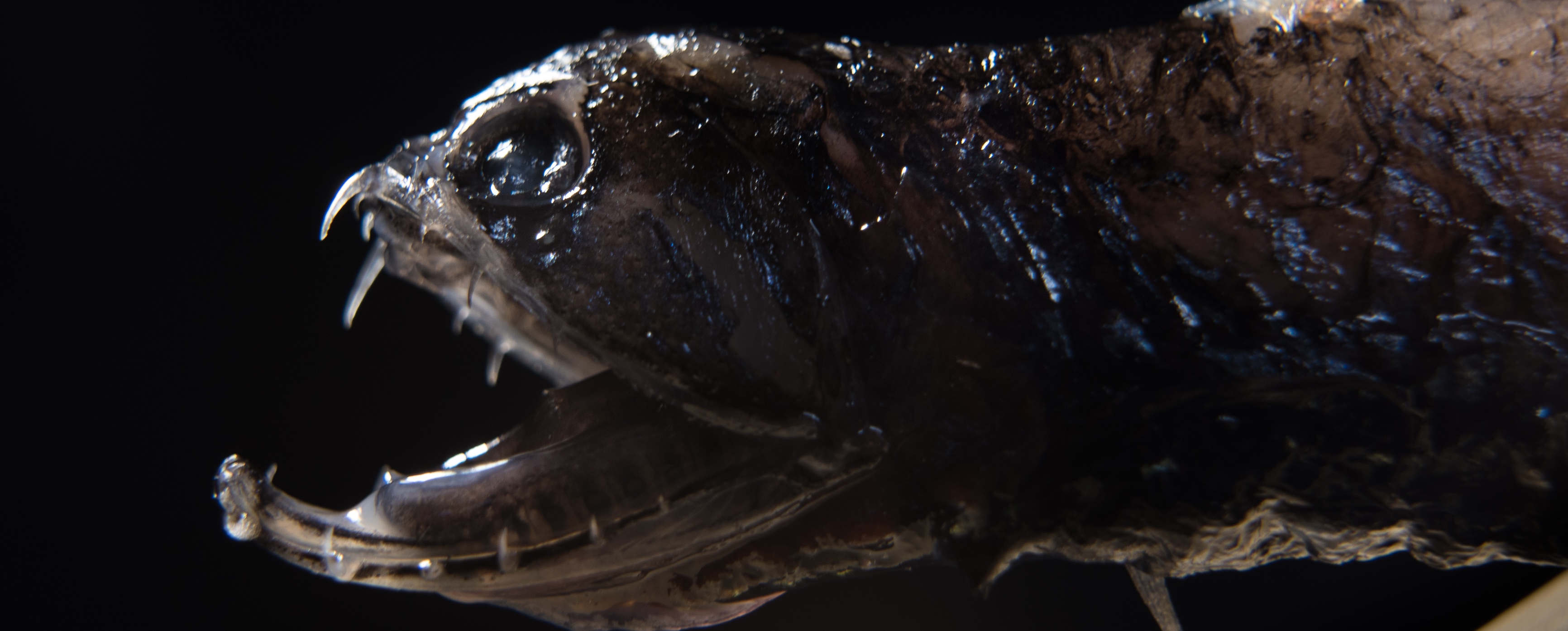Global S&T Development Trend Analysis Platform of Resources and Environment
| Researchers discover what makes deep-sea dragonfish teeth transparent | |
| admin | |
| 2019-06-05 | |
| 发布年 | 2019 |
| 语种 | 英语 |
| 国家 | 美国 |
| 领域 | 资源环境 |
| 正文(英文) |  A team of researchers led by the University of California San Diego’s Jacobs School of Engineering and Scripps Institution of Oceanography have discovered what’s responsible for making the teeth of the deep-sea dragonfish transparent. This unique adaptation, which helps camouflage the dragonfish from their prey, results from their teeth having an unusually crystalline nanostructure mixed with amorphous regions. The findings could provide “bioinspiration” for researchers looking to develop transparent ceramics. Researchers detail their findings in a paper published June 5 in the journal Matter. Deep-sea creatures have evolved some fascinating adaptations such as bioluminescence, eyes that can see in low light, and mouths that can engulf much larger prey. Some species, such as the deep-sea dragonfish (Aristostomias scintillans), have transparent teeth. “It’s an adaptation that, to our knowledge, has not yet been explored in detail,” said Audrey Velasco-Hogan, a materials science PhD student at the UC San Diego Jacobs School of Engineering and first author of the study. “By studying why these teeth are transparent, we can better understand deep-sea organisms like the dragonfish and the adaptations they evolved to live in their environments.” Velasco-Hogan collaborated with Dimitri Deheyn, a marine biologist at the Scripps Institution of Oceanography who researches bioluminescence and biomimicry and suggested the idea for the study. “Taking advantage of the ultimate adaptation organisms show to specific environments has always been a driver for technological innovation, and the dragonfish is no exception to this,” said Deheyn. “There is broad inspiration to gather from the dragonfish and nature in general, and this intercept between biology and engineering through biomimicry is clearly a path for innovation.” Transparent teeth, along with a dark body, make the dragonfish essentially invisible to their prey, explained Velasco-Hogan. Because of this camouflage, dragonfish are among the top predators of the deep sea despite being small (measuring about 15 centimeters long) and relatively slow. “They spend most of their time sitting around with their jaws open, waiting for something to come by. Their teeth are always exposed, so it’s important that they are transparent so they don’t reflect or scatter any bioluminescent light from the environment,” Velasco-Hogan said. To solve the mysteries of the dragonfish’s dental disguise, Velasco-Hogan and Deheyn imaged and analyzed teeth from dragonfish. They looked at the nanostructure of the teeth using a combination of electron microscopy, focused ion beam and nanoindentation tests. They discovered that the teeth have unique characteristics both in their outer enamel-like layer and inner dentin layer. The enamel-like layer consists of hydroxyapatite nanocrystals structured in a way that prevents light from scattering or reflecting off the surface of the teeth. The dentin layer is also structured in its own particular way. It lacks microscopic channels called dentin tubules, which are what give the teeth of humans and other animals their color. The absence of tubules is also responsible for making dragonfish teeth transparent. “Typically, teeth are not nanostructured. And they tend to have microscale features such as dentin tubules. From a materials perspective, it’s really interesting to see that dragonfish teeth have architectures that we do not see in others,” Velasco-Hogan said. “I also find it fascinating how there are fundamental similarities between materials in the lab and in nature,” she added. “Experimentally, we know that the way to make a material transparent is by reducing its grain size to make it nanostructured. So to see that is also how nature is accomplishing transparency is an interesting parallel.” The team also involved the lab of Eduard Arzt, Director of the Leibniz Institute for New Materials (INM) in Saarbrücken, Germany. Marcus Koch, who is Head of Physical Analytics at INM, analyzed the nanostructure of the teeth with a specialized electron microscope. Birgit Nothdurft, a technician in the Division of Physical Analytics at INM, performed a highly specialized preparation of the specimens. Paper title: “On the nature of the transparent teeth of the deep-sea dragonfish (Aristostomias scintillans).” This work was supported by the Air Force Office of Research (grants FA9550-15-0009 and FA9550-10-1-0555), the German Humboldt Foundation, and the Biomimicry for Emerging Science and Technology Initiative. |
| URL | 查看原文 |
| 来源平台 | Scripps Institution of Oceanography |
| 文献类型 | 新闻 |
| 条目标识符 | http://119.78.100.173/C666/handle/2XK7JSWQ/130461 |
| 专题 | 资源环境科学 |
| 推荐引用方式 GB/T 7714 | admin. Researchers discover what makes deep-sea dragonfish teeth transparent. 2019. |
| 条目包含的文件 | 条目无相关文件。 | |||||
| 个性服务 |
| 推荐该条目 |
| 保存到收藏夹 |
| 查看访问统计 |
| 导出为Endnote文件 |
| 谷歌学术 |
| 谷歌学术中相似的文章 |
| [admin]的文章 |
| 百度学术 |
| 百度学术中相似的文章 |
| [admin]的文章 |
| 必应学术 |
| 必应学术中相似的文章 |
| [admin]的文章 |
| 相关权益政策 |
| 暂无数据 |
| 收藏/分享 |
除非特别说明,本系统中所有内容都受版权保护,并保留所有权利。
修改评论